trunk release DODGE DART 2015 PF / 1.G Owners Manual
[x] Cancel search | Manufacturer: DODGE, Model Year: 2015, Model line: DART, Model: DODGE DART 2015 PF / 1.GPages: 664, PDF Size: 16.96 MB
Page 12 of 664
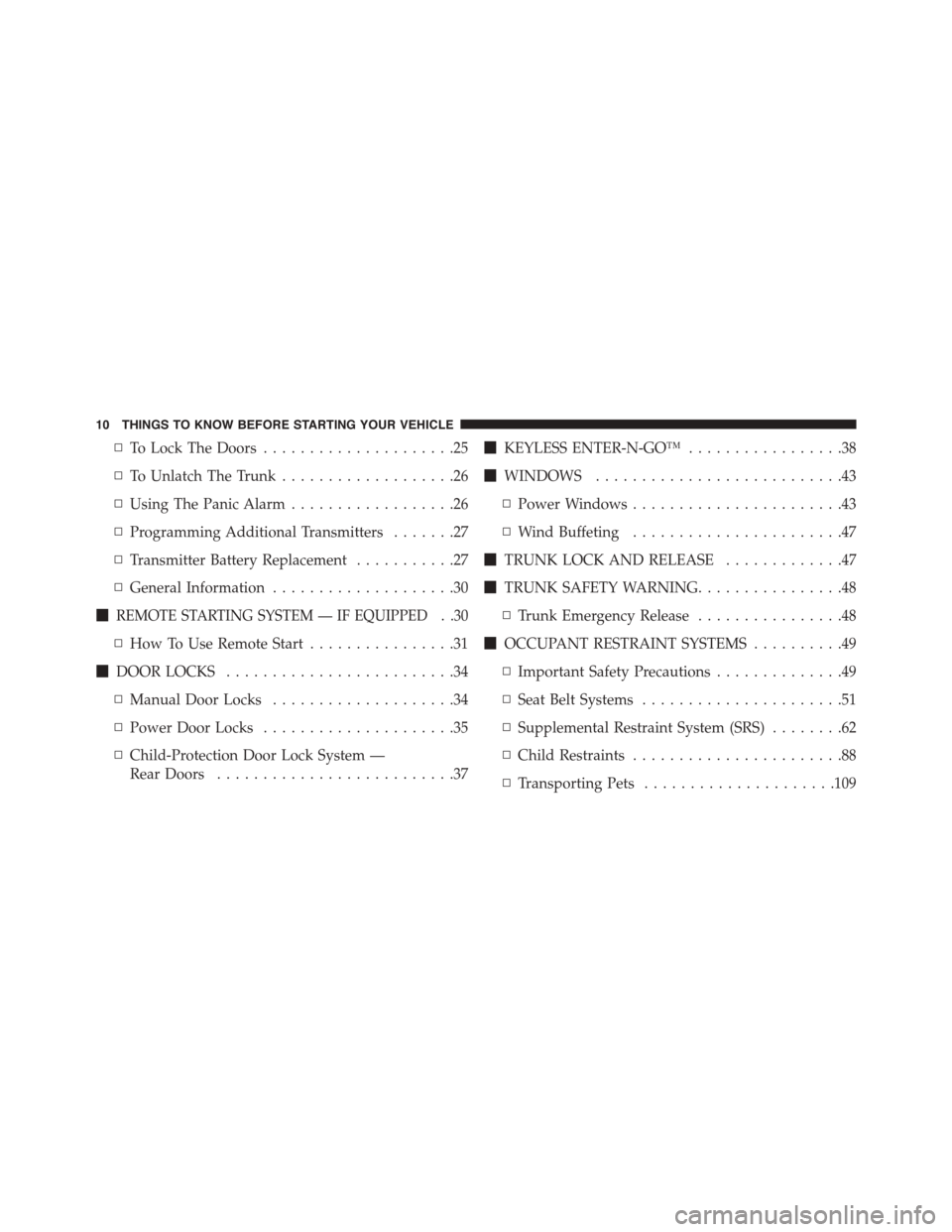
▫To Lock The Doors.....................25
▫To Unlatch The Trunk...................26
▫Using The Panic Alarm..................26
▫Programming Additional Transmitters.......27
▫Transmitter Battery Replacement...........27
▫General Information....................30
!REMOTE STARTING SYSTEM — IF EQUIPPED . .30
▫How To Use Remote Start................31
!DOOR LOCKS.........................34
▫Manual Door Locks....................34
▫Power Door Locks.....................35
▫Child-Protection Door Lock System —
Rear Doors..........................37
!KEYLESS ENTER-N-GO™.................38
!WINDOWS...........................43
▫Power Windows.......................43
▫Wind Buffeting.......................47
!TRUNK LOCK AND RELEASE.............47
!TRUNK SAFETY WARNING................48
▫Trunk Emergency Release................48
!OCCUPANT RESTRAINT SYSTEMS..........49
▫Important Safety Precautions..............49
▫Seat Belt Systems......................51
▫Supplemental Restraint System (SRS)........62
▫Child Restraints.......................88
▫Transporting Pets.....................109
10 THINGS TO KNOW BEFORE STARTING YOUR VEHICLE
Page 28 of 664
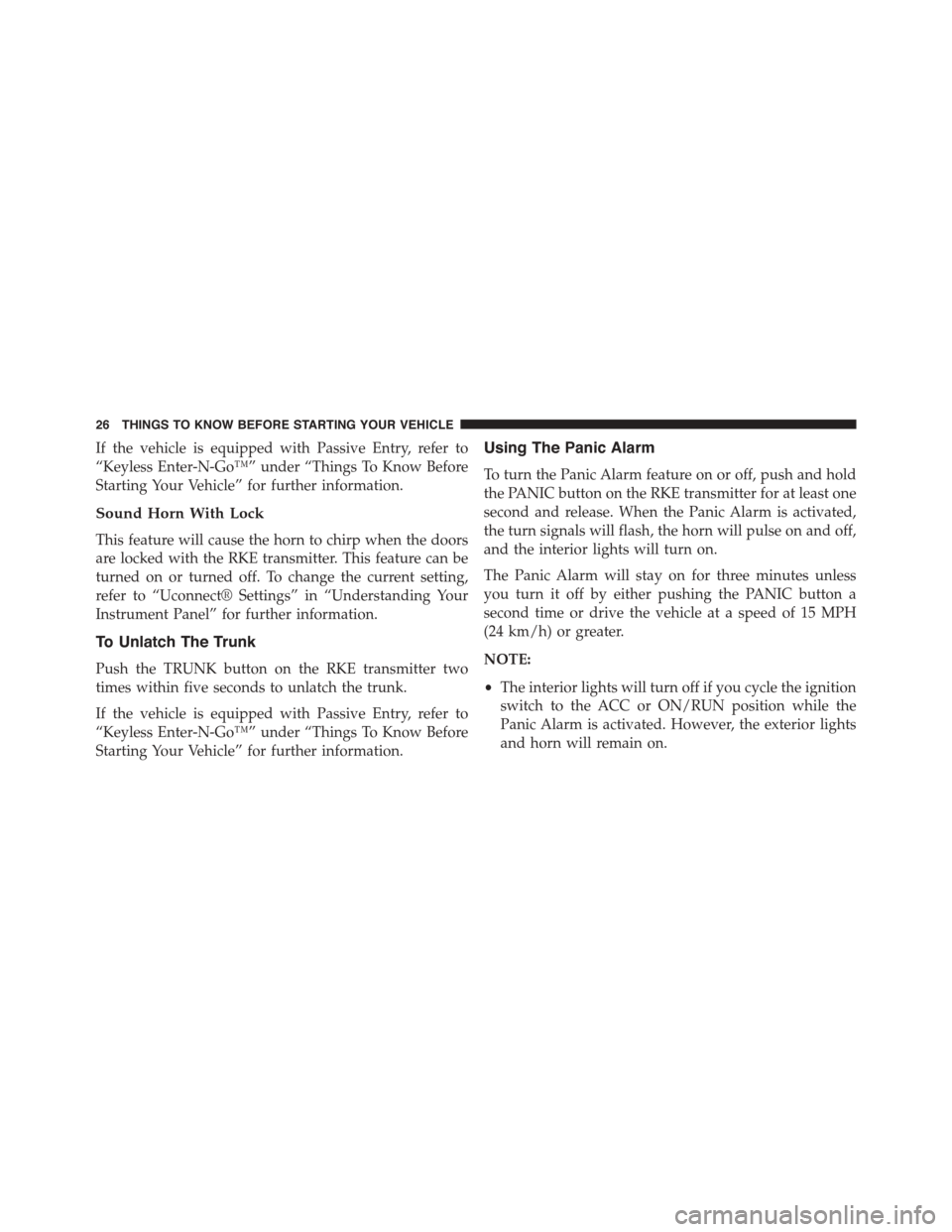
If the vehicle is equipped with Passive Entry, refer to
“Keyless Enter-N-Go™” under “Things To Know Before
Starting Your Vehicle” for further information.
Sound Horn With Lock
This feature will cause the horn to chirp when the doors
are locked with the RKE transmitter. This feature can be
turned on or turned off. To change the current setting,
refer to “Uconnect® Settings” in “Understanding Your
Instrument Panel” for further information.
To Unlatch The Trunk
Push the TRUNK button on the RKE transmitter two
times within five seconds to unlatch the trunk.
If the vehicle is equipped with Passive Entry, refer to
“Keyless Enter-N-Go™” under “Things To Know Before
Starting Your Vehicle” for further information.
Using The Panic Alarm
To turn the Panic Alarm feature on or off, push and hold
the PANIC button on the RKE transmitter for at least one
second and release. When the Panic Alarm is activated,
the turn signals will flash, the horn will pulse on and off,
and the interior lights will turn on.
The Panic Alarm will stay on for three minutes unless
you turn it off by either pushing the PANIC button a
second time or drive the vehicle at a speed of 15 MPH
(24 km/h) or greater.
NOTE:
•The interior lights will turn off if you cycle the ignition
switch to the ACC or ON/RUN position while the
Panic Alarm is activated. However, the exterior lights
and horn will remain on.
26 THINGS TO KNOW BEFORE STARTING YOUR VEHICLE
Page 34 of 664
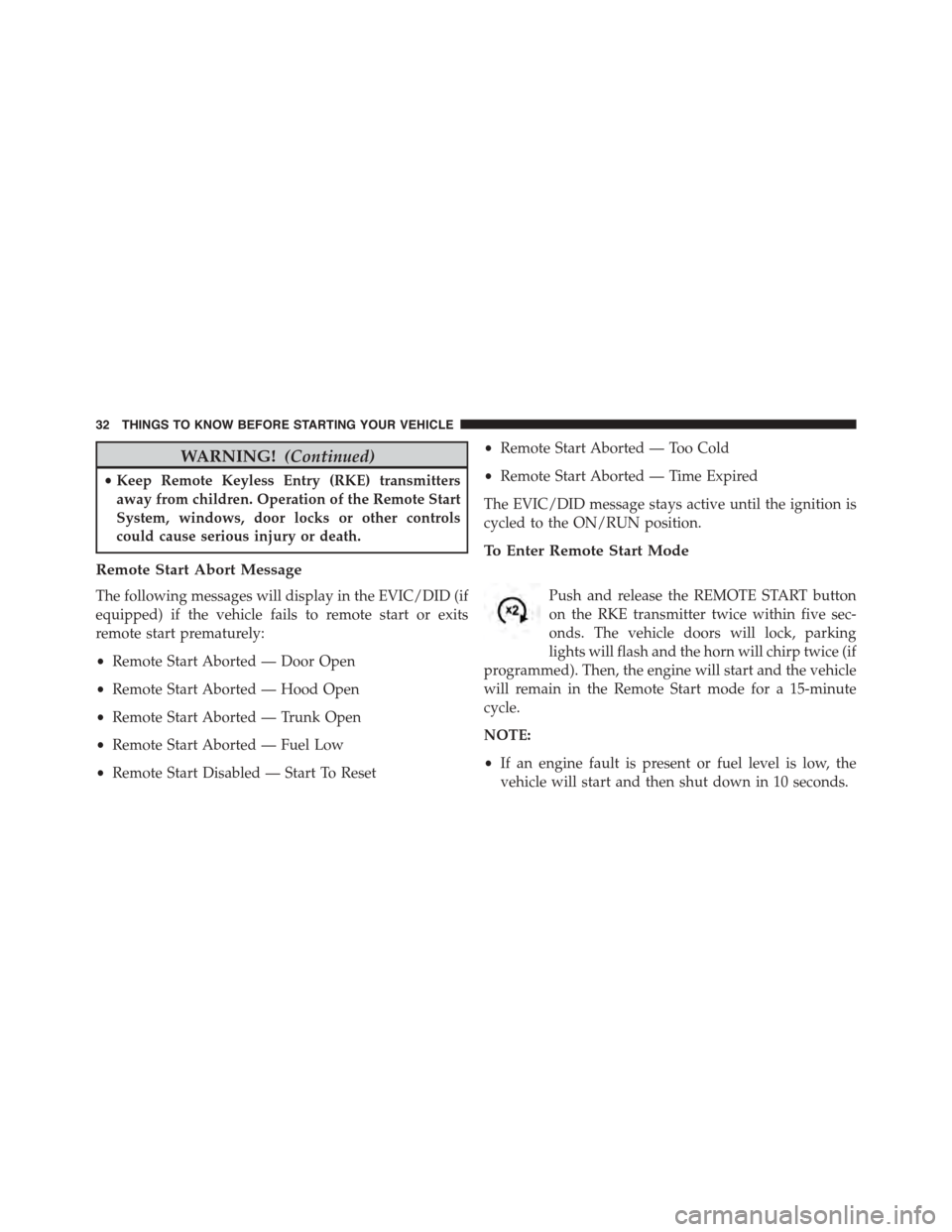
WARNING!(Continued)
•Keep Remote Keyless Entry (RKE) transmitters
away from children. Operation of the Remote Start
System, windows, door locks or other controls
could cause serious injury or death.
Remote Start Abort Message
The following messages will display in the EVIC/DID (if
equipped) if the vehicle fails to remote start or exits
remote start prematurely:
•Remote Start Aborted — Door Open
•Remote Start Aborted — Hood Open
•Remote Start Aborted — Trunk Open
•Remote Start Aborted — Fuel Low
•Remote Start Disabled — Start To Reset
•Remote Start Aborted — Too Cold
•Remote Start Aborted — Time Expired
The EVIC/DID message stays active until the ignition is
cycled to the ON/RUN position.
To Enter Remote Start Mode
Push and release the REMOTE START button
on the RKE transmitter twice within five sec-
onds. The vehicle doors will lock, parking
lights will flash and the horn will chirp twice (if
programmed). Then, the engine will start and the vehicle
will remain in the Remote Start mode for a 15-minute
cycle.
NOTE:
•If an engine fault is present or fuel level is low, the
vehicle will start and then shut down in 10 seconds.
32 THINGS TO KNOW BEFORE STARTING YOUR VEHICLE
Page 49 of 664
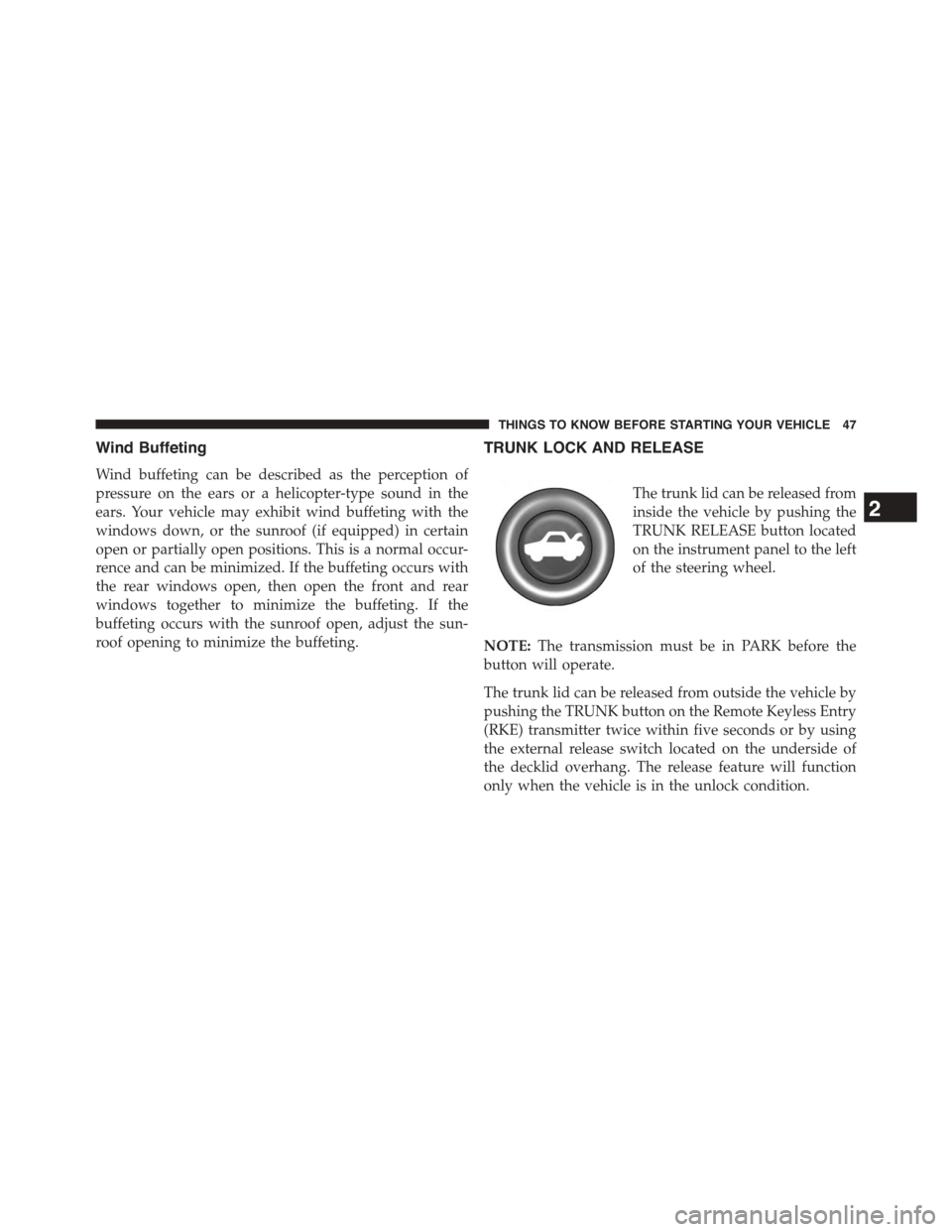
Wind Buffeting
Wind buffeting can be described as the perception of
pressure on the ears or a helicopter-type sound in the
ears. Your vehicle may exhibit wind buffeting with the
windows down, or the sunroof (if equipped) in certain
open or partially open positions. This is a normal occur-
rence and can be minimized. If the buffeting occurs with
the rear windows open, then open the front and rear
windows together to minimize the buffeting. If the
buffeting occurs with the sunroof open, adjust the sun-
roof opening to minimize the buffeting.
TRUNK LOCK AND RELEASE
The trunk lid can be released from
inside the vehicle by pushing the
TRUNK RELEASE button located
on the instrument panel to the left
of the steering wheel.
NOTE:The transmission must be in PARK before the
button will operate.
The trunk lid can be released from outside the vehicle by
pushing the TRUNK button on the Remote Keyless Entry
(RKE) transmitter twice within five seconds or by using
the external release switch located on the underside of
the decklid overhang. The release feature will function
only when the vehicle is in the unlock condition.
2
THINGS TO KNOW BEFORE STARTING YOUR VEHICLE 47
Page 50 of 664
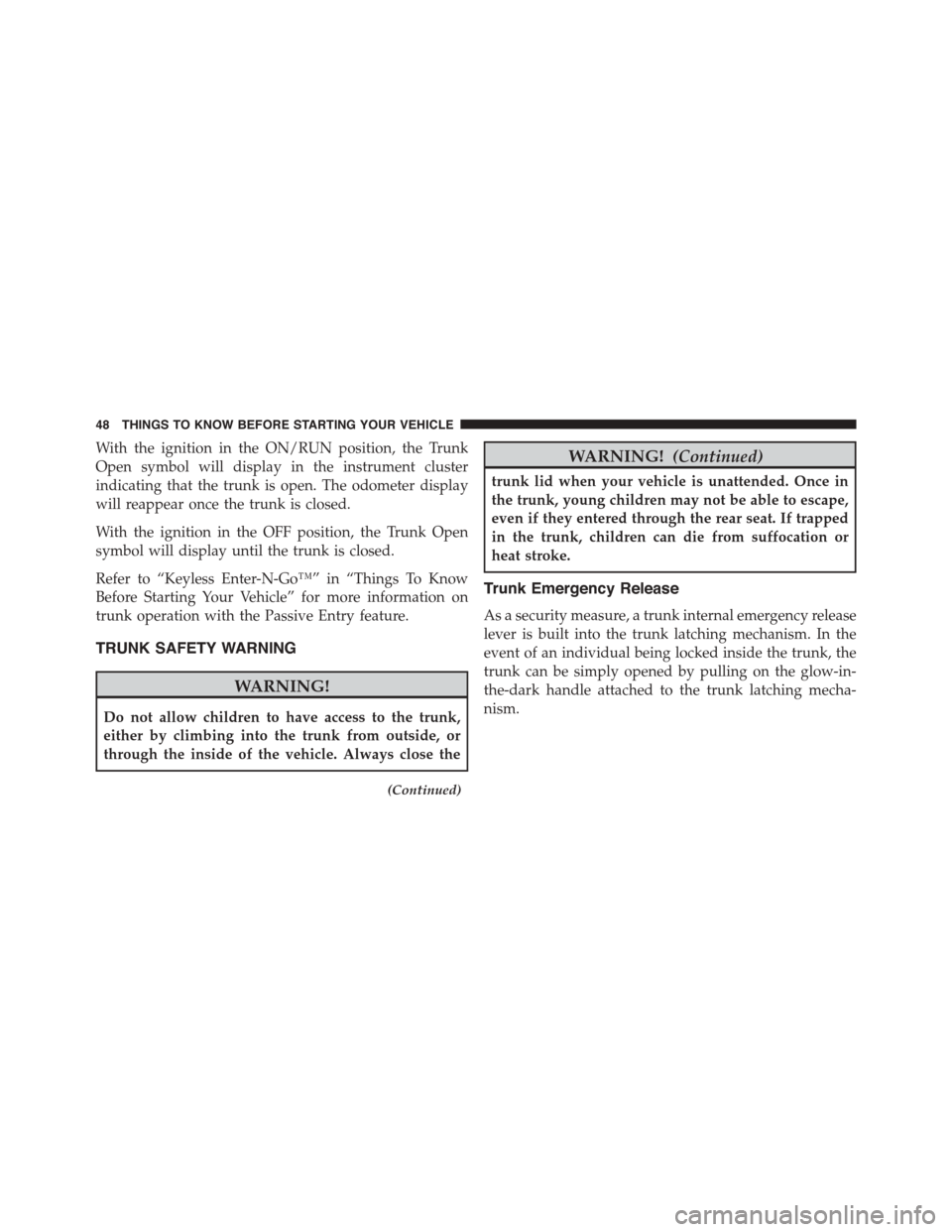
With the ignition in the ON/RUN position, the Trunk
Open symbol will display in the instrument cluster
indicating that the trunk is open. The odometer display
will reappear once the trunk is closed.
With the ignition in the OFF position, the Trunk Open
symbol will display until the trunk is closed.
Refer to “Keyless Enter-N-Go™” in “Things To Know
Before Starting Your Vehicle” for more information on
trunk operation with the Passive Entry feature.
TRUNK SAFETY WARNING
WARNING!
Do not allow children to have access to the trunk,
either by climbing into the trunk from outside, or
through the inside of the vehicle. Always close the
(Continued)
WARNING!(Continued)
trunk lid when your vehicle is unattended. Once in
the trunk, young children may not be able to escape,
even if they entered through the rear seat. If trapped
in the trunk, children can die from suffocation or
heat stroke.
Trunk Emergency Release
As a security measure, a trunk internal emergency release
lever is built into the trunk latching mechanism. In the
event of an individual being locked inside the trunk, the
trunk can be simply opened by pulling on the glow-in-
the-dark handle attached to the trunk latching mecha-
nism.
48 THINGS TO KNOW BEFORE STARTING YOUR VEHICLE
Page 51 of 664
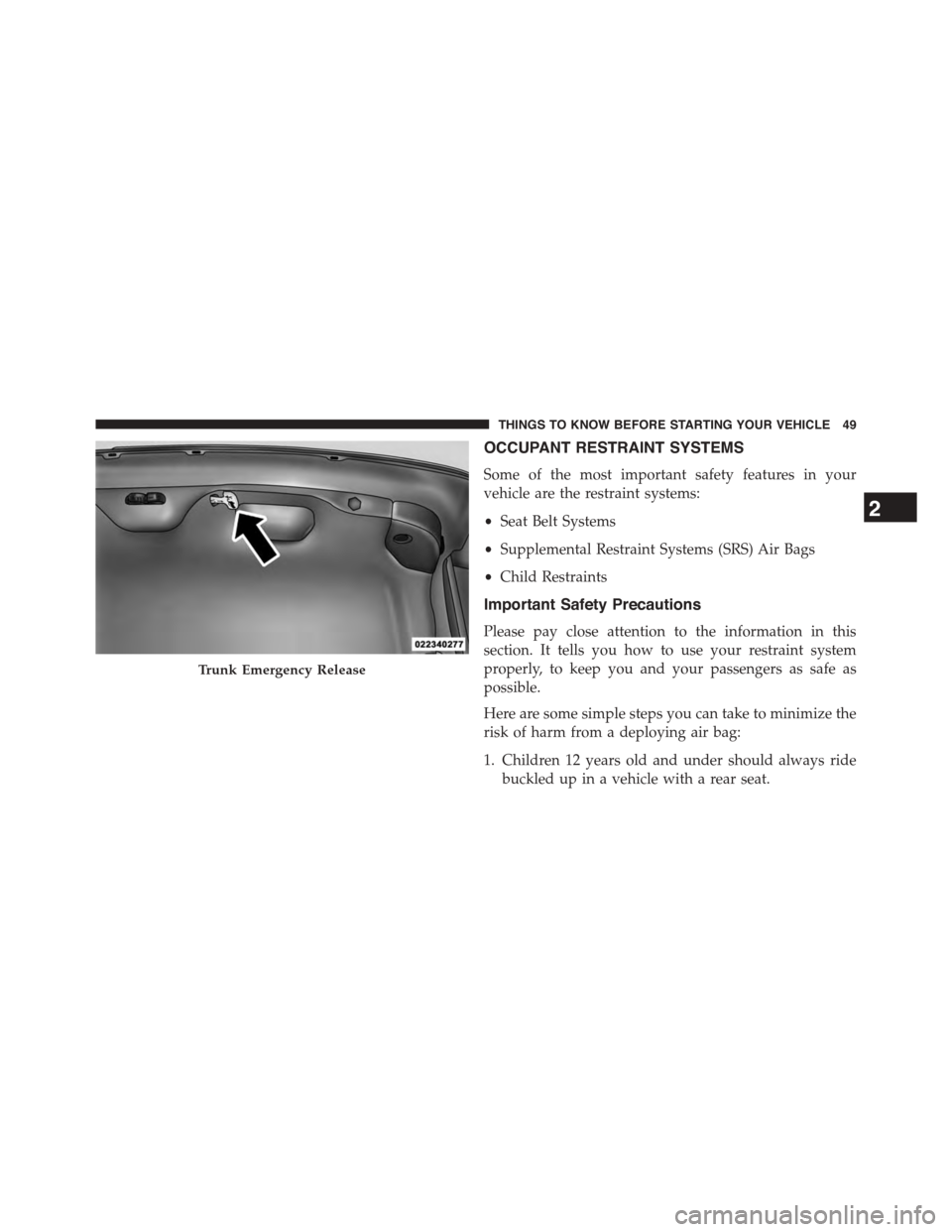
OCCUPANT RESTRAINT SYSTEMS
Some of the most important safety features in your
vehicle are the restraint systems:
•Seat Belt Systems
•Supplemental Restraint Systems (SRS) Air Bags
•Child Restraints
Important Safety Precautions
Please pay close attention to the information in this
section. It tells you how to use your restraint system
properly, to keep you and your passengers as safe as
possible.
Here are some simple steps you can take to minimize the
risk of harm from a deploying air bag:
1. Children 12 years old and under should always ride
buckled up in a vehicle with a rear seat.
Trunk Emergency Release
2
THINGS TO KNOW BEFORE STARTING YOUR VEHICLE 49
Page 306 of 664
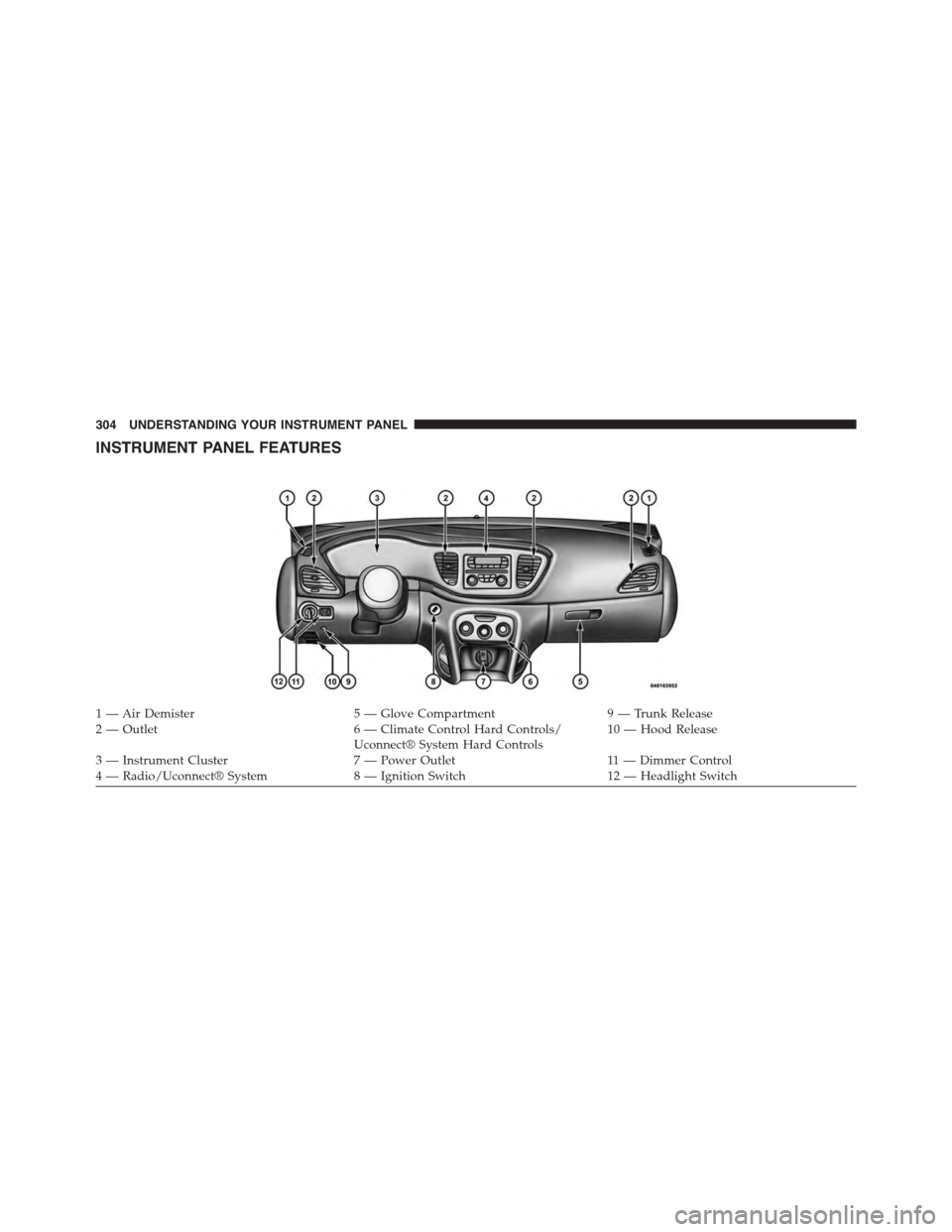
INSTRUMENT PANEL FEATURES
1—AirDemister5—GloveCompartment9—TrunkRelease2 — Outlet6 — Climate Control Hard Controls/Uconnect® System Hard Controls10 — Hood Release
3 — Instrument Cluster7 — Power Outlet11 — Dimmer Control4 — Radio/Uconnect® System8 — Ignition Switch12 — Headlight Switch
304 UNDERSTANDING YOUR INSTRUMENT PANEL
Page 328 of 664
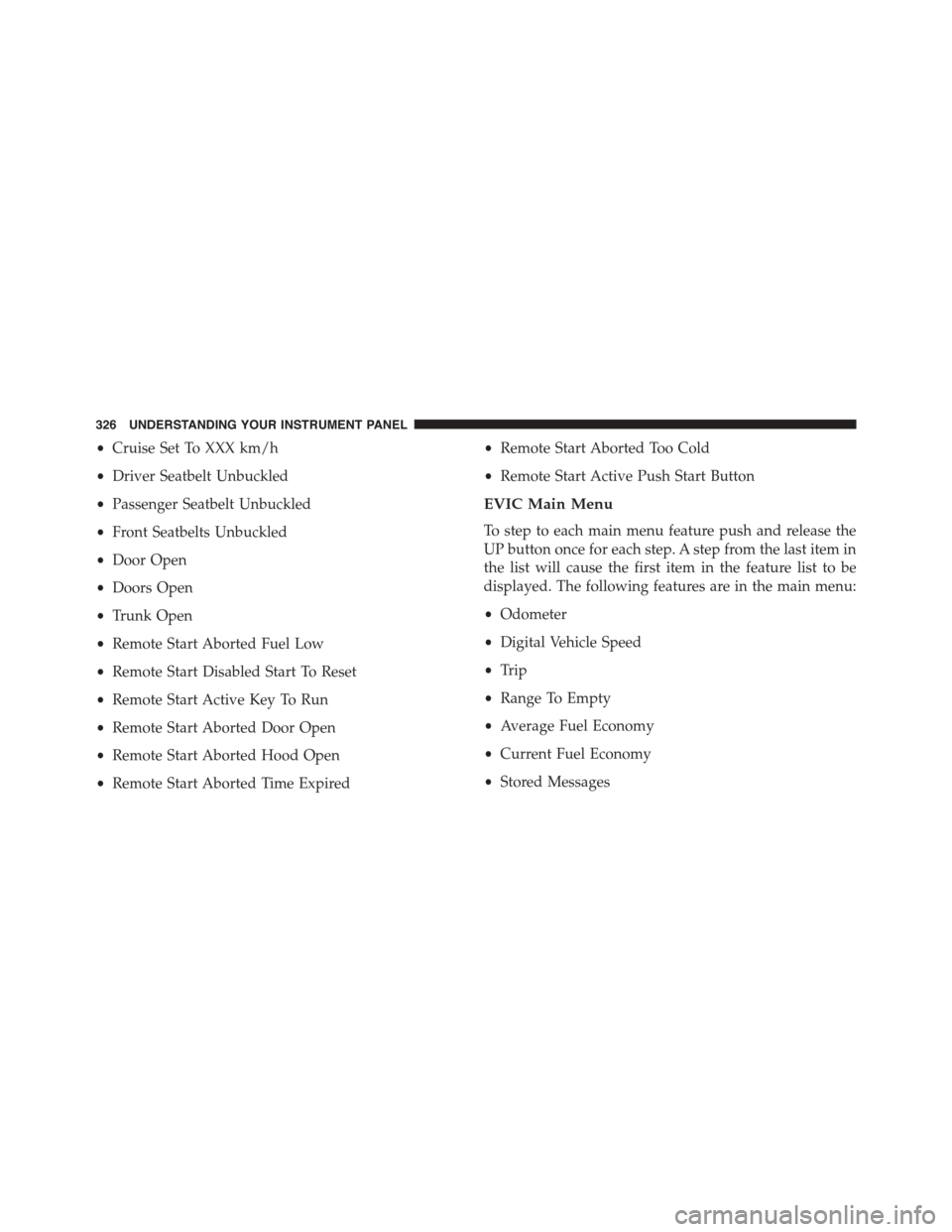
•Cruise Set To XXX km/h
•Driver Seatbelt Unbuckled
•Passenger Seatbelt Unbuckled
•Front Seatbelts Unbuckled
•Door Open
•Doors Open
•Trunk Open
•Remote Start Aborted Fuel Low
•Remote Start Disabled Start To Reset
•Remote Start Active Key To Run
•Remote Start Aborted Door Open
•Remote Start Aborted Hood Open
•Remote Start Aborted Time Expired
•Remote Start Aborted Too Cold
•Remote Start Active Push Start Button
EVIC Main Menu
To step to each main menu feature push and release the
UP button once for each step. A step from the last item in
the list will cause the first item in the feature list to be
displayed. The following features are in the main menu:
•Odometer
•Digital Vehicle Speed
•Trip
•Range To Empty
•Average Fuel Economy
•Current Fuel Economy
•Stored Messages
326 UNDERSTANDING YOUR INSTRUMENT PANEL
Page 507 of 664
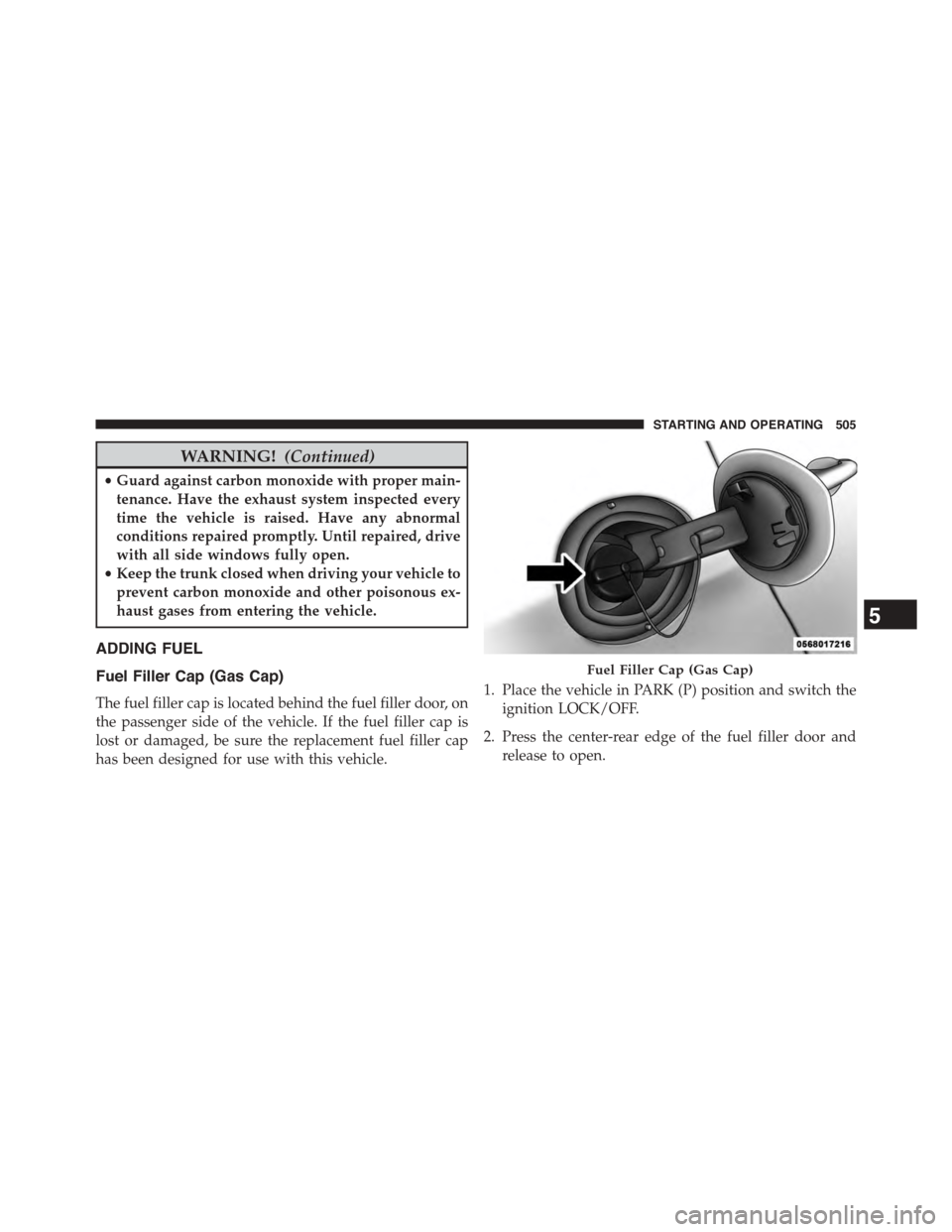
WARNING!(Continued)
•Guard against carbon monoxide with proper main-
tenance. Have the exhaust system inspected every
time the vehicle is raised. Have any abnormal
conditions repaired promptly. Until repaired, drive
with all side windows fully open.
•Keep the trunk closed when driving your vehicle to
prevent carbon monoxide and other poisonous ex-
haust gases from entering the vehicle.
ADDING FUEL
Fuel Filler Cap (Gas Cap)
The fuel filler cap is located behind the fuel filler door, on
the passenger side of the vehicle. If the fuel filler cap is
lost or damaged, be sure the replacement fuel filler cap
has been designed for use with this vehicle.
1. Place the vehicle in PARK (P) position and switch the
ignition LOCK/OFF.
2. Press the center-rear edge of the fuel filler door and
release to open.
Fuel Filler Cap (Gas Cap)
5
STARTING AND OPERATING 505
Page 647 of 664
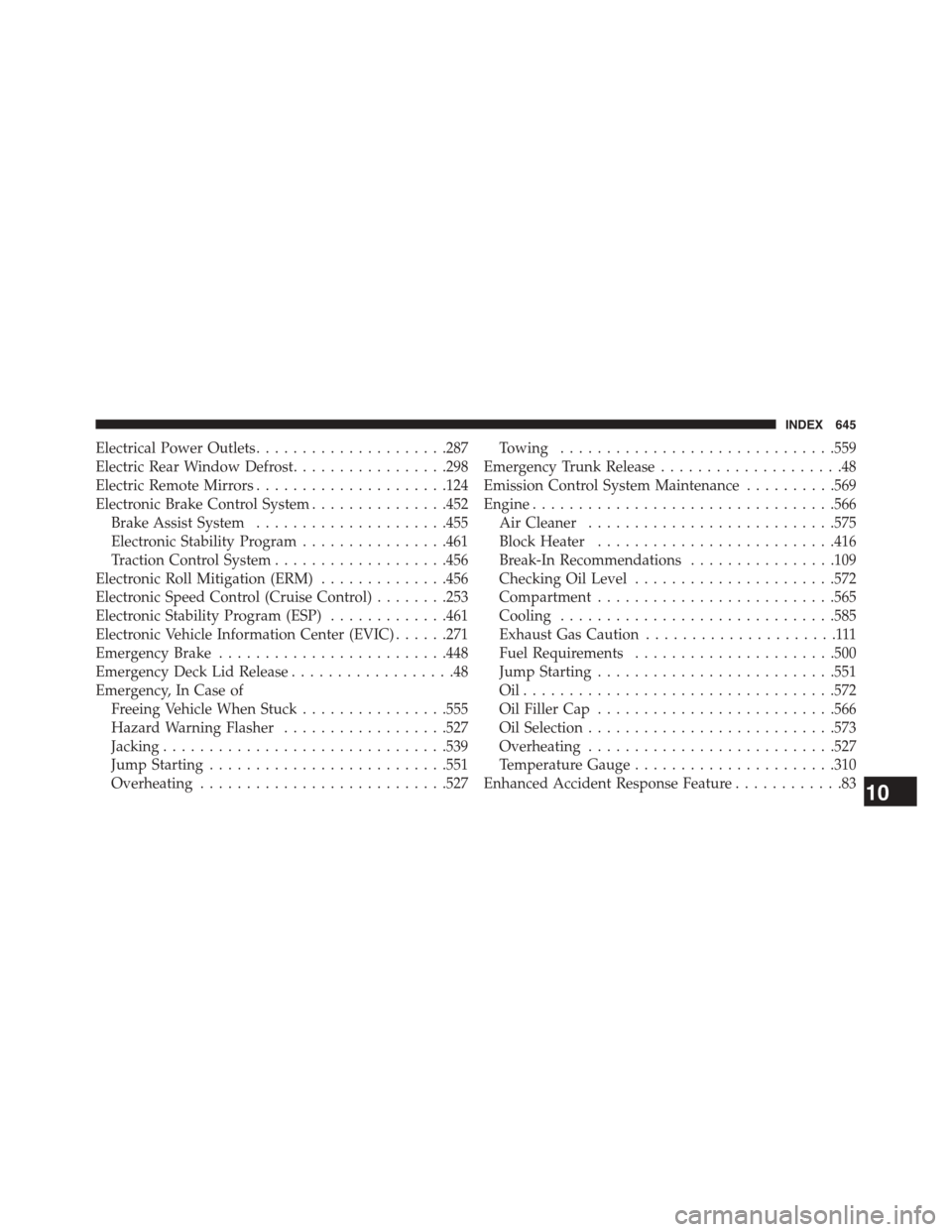
Electrical Power Outlets.....................287
Electric Rear Window Defrost.................298
Electric Remote Mirrors.....................124
Electronic Brake Control System...............452
Brake Assist System.....................455
Electronic Stability Program................461
Traction Control System...................456
Electronic Roll Mitigation (ERM)..............456
Electronic Speed Control (Cruise Control)........253
Electronic Stability Program (ESP).............461
Electronic Vehicle Information Center (EVIC)......271
Emergency Brake.........................448
Emergency Deck Lid Release..................48
Emergency, In Case of
Freeing Vehicle When Stuck................555
Hazard Warning Flasher..................527
Jacking...............................539
Jump Starting..........................551
Overheating...........................527
Towing..............................559
Emergency Trunk Release....................48
Emission Control System Maintenance..........569
Engine.................................566
Air Cleaner...........................575
Block Heater..........................416
Break-In Recommendations................109
Checking Oil Level......................572
Compartment..........................565
Cooling..............................585
Exhaust Gas Caution.....................111
Fuel Requirements......................500
Jump Starting..........................551
Oil . . . . . . . . . . . . . . . . . . . . . . . . . . . . . . . . ..572
Oil Filler Cap..........................566
Oil Selection...........................573
Overheating...........................527
Temperature Gauge......................310
Enhanced Accident Response Feature............8310
INDEX 645